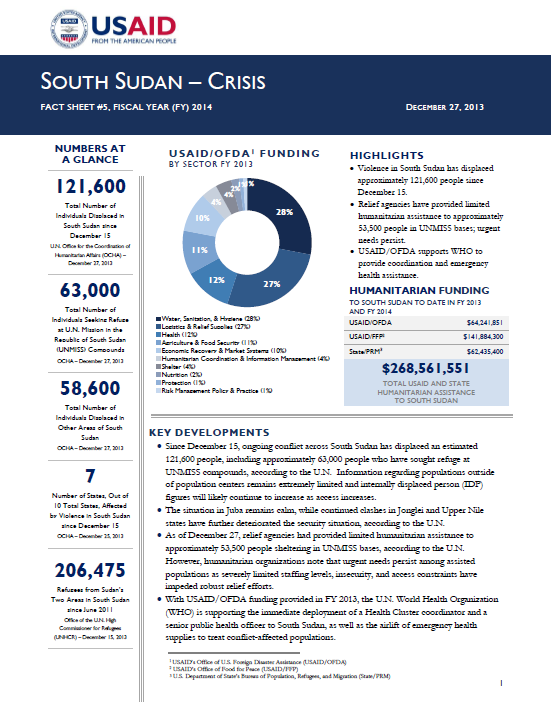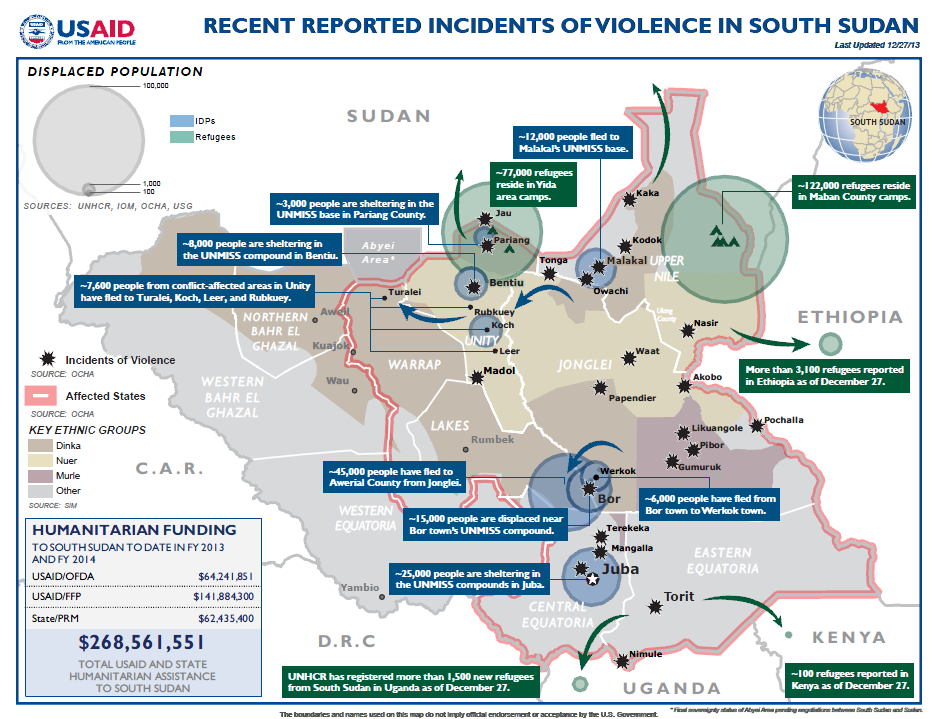- What We Do
- Agriculture and Food Security
- Democracy, Human Rights and Governance
- Economic Growth and Trade
- Education
- Environment and Global Climate Change
- Gender Equality and Women's Empowerment
- Global Health
- Humanitarian Assistance
- Transformation at USAID
- Water and Sanitation
- Working in Crises and Conflict
- U.S. Global Development Lab
Speeches Shim
June 6, 2014
Numbers At A Glance
1,040,700
95,000
945,700
381,600
239,200
Humanitarian Funding:
To South Sudan To Date In FY2014:
| USAID/OFDA | $110,000,000 |
| USAID/FFP | $147,400,000 |
| USAID/AFR | $14,200,000 |
| State/PRM | $73,300,000 |
| TOTAL | $344,900,000 |
Highlights
Though cholera case fatality rate drops, populations remain at risk, with more than 1,250 cases reported in Central Equatoria State between April 23 and June 3.
The U.N. World Food Program (WFP) scales up efforts to distribute assistance via air and river routes as rainy season progresses.
KEY DEVELOPMENTS
Although health actors have reported fewer cholera-related deaths in recent days, the case fatality rate remains above the U.N. World Health Organization (WHO) emergency threshold of 1 percent. The Government of the Republic of South Sudan (RSS) and relief agencies continue efforts to mitigate the spread of the disease and treat affected individuals.
Efforts to improve conditions at existing UNMISS protection of civilian (PoC) sites continue. The International Organization for Migration (IOM) reports that internally displaced persons (IDPs) at the UNMISS base in Malakal have begun relocating to the new PoC extension site. IDP relocation in Juba town, Central Equatoria, from the PoC area at Tomping to the new PoC 3 site at U.N. House is expected to begin in the coming weeks.
USAID/FFP Director Dina Esposito recently traveled to South Sudan to assess partner capacities as part of USAID’s crisis response. Ms. Esposito travelled to Jonglei and Lakes states, where she met community leaders, witnessed WFP distributions, and toured milling stations and storage facilities. She also visited the country’s largest concentration of IDPs in Mingkaman town, Lakes, which hosts more than 90,000 IDPs.
INSECURITY, DISPLACEMENT, AND ACCESS CONSTRAINTS
Hostilities in South Sudan since December 15 have displaced more than 1.4 million people, including approximately 1 million internally displaced persons (IDPs) and 381,300 people who are seeking refuge in neighboring countries.
Although relief actors have not reported major clashes since May 30, tensions remain high in Jonglei, Unity, and Upper Nile states. Insecurity remains a major challenge to providing assistance to populations in need.
HUMANITARIAN NEEDS ASSESSMENTS AND RESPONSE ACTIVITIES
Two mobile rapid response teams, comprising staff from WFP and the U.N. Children’s Fund (UNICEF), are responding to the humanitarian needs of approximately 50,000 displaced persons in Wau Shiluk town, Upper Nile, and Jiech town, Jonglei, according to WFP. Additional mobile response teams are scheduled to deploy to Unity’s Mayendit and Nyal towns and to Jonglei’s Haat town in the coming days to conduct a second round of food commodity distributions.
South Sudan Crisis Fact Sheet #45, June 6. 2014 ![]() (pdf - 268k)
(pdf - 268k)
South Sudan Crisis Map, June 6. 2014 ![]() (pdf - 933k)
(pdf - 933k)
CAMP COORDINATION AND CAMP MANAGEMENT
Relief organizations continue efforts to improve living conditions for the 95,000 IDPs sheltering at UNMISS bases across the country. In preparation for the planned relocation of IDPs from the Tomping PoC site in Juba to the new PoC 3 area at U.N. House, relief actors are finalizing site preparations, including constructing health care, water, and sanitation infrastructure at the new site. UNMISS and humanitarian partners are finalizing security arrangements at the site, and expect relocation to begin in the coming weeks, according to IOM.
Meanwhile, humanitarian actors continue to provide humanitarian assistance to IDPs relocating from the PoC site at the UNMISS base in Malakal town, Upper Nile, to the new Malakal PoC extension site. IOM is increasing efforts to ensure IDPs have access to safe drinking water at the new site and reports that the construction of a water treatment plant is progressing. IDPs began moving into the new site—which has the capacity to host 10,000 people in approximately 1,060 tents—on May 31, according to IOM.
Efforts to decrease congestion in other PoC sites continue. In Bor town, Jonglei, state authorities recently granted partners space to construct a new PoC site. In addition, UNMISS accepted a proposal to extend the perimeter of the existing PoC site in Bentiu town, Unity, to accommodate an additional 10,000 individuals.
AGRICULTURE, FOOD SECURITY, AND NUTRITION
Most cropping areas of South Sudan received above-average amounts of rainfall between March and June, resulting in favorable planting conditions, according to the Global Information and Early Warning System (GIEWS)—a project of the U.N. Food and Agriculture Organization (FAO). However, conflict and insecurity, particularly in areas of Jonglei, Unity, and Upper Nile, disrupted planting and cultivation activities, resulting in reduced area planted. GIEWS reports that the food security outlook is likely to further deteriorate through at least August and notes that protecting crop production capacity in less-conflict-affected areas is necessary to ensure country-wide food security in 2015.
Following several months of access challenges that limited the ability of relief agencies to provide adequate assistance to refugees in Maban County, Upper Nile, WFP plans to provide refugees in Maban with a full 30-day food ration in June. The refugees received a seven-day ration in March, a 10-day ration in April, and a 20-day ration in May, according to UNHCR. WFP hopes to transport food commodities via air, land, and river to enhance delivery capacity. In addition, UNHCR plans to distribute 45 metric tons (MT) of seeds to the Maban refugees in the coming days to enhance local food production.
HEALTH AND WASH
The cholera outbreak in South Sudan has continued to spread since late April, including to locations outside Juba town, such as areas of Jonglei and Upper Nile, according to health partners. Between April 23 and June 3, health actors reported approximately 1,250 cases of cholera in Juba, including 29 cholera-related deaths. Despite fewer reported cases in recent days, the outbreak’s case fatality rate remains above the WHO emergency threshold of 1 percent.
In response, health and water, sanitation, and hygiene (WASH) actors are conducting social mobilization and surveillance activities, distributing WASH-related relief supplies, and treating cholera-affected individuals.
As of May 31, the Health Cluster—the coordinating body for humanitarian health activities, comprising U.N. agencies, non-governmental organizations (NGOs), and other stakeholders—had provided oral cholera vaccinations to nearly 34,400 people sheltering at the UNMISS PoC area in Bentiu, reaching approximately 90 percent of the 38,000 IDPs in the site.
Several USAID-supported programs are helping to mitigate the spread of cholera in South Sudan. Sustainable Water and Sanitation in Africa (SUWASA)—a USAID regional initiative that aims to improve and expand the delivery of WASH services in urban settings—plans to advise Juba City Council, Roton Wastewater Lagoon, and Urban Water Association staff on improved waste treatment and disposal practices. SUWASA will also purchase protective equipment and supplies for sewage truckers to ensure the cholera outbreak is not exacerbated by improper waste disposal and will continue water treatment efforts—particularly around water tanker filling stations—as part of the SUWASA Juba urban water management mandate.
Through the Integrated Service Delivery Program, led by international NGO Jhpiego, USAID has supported water treatment services in communities located around health facilities; supplied health facilities with cleaning supplies, oral rehydration salts, and chlorine tablets; deployed social mobilizers to at-risk communities; conducted WASH assessments at health care centers in Juba; and coordinated cholera-related trainings for health facility staff.
LOGISTICS AND RELIEF COMMODITIES
As predicted, the ongoing April-to-August rainy season is hindering road transportation efforts. Rains have affected the road from Juba to Rumbek town, Lakes State, and Wau town, Western Bahr el Ghazal State, and have rendered the main road between Kuajok town and Tonj East County, Warrap State, impassable, according to WFP.
In response, WFP is scaling up efforts to provide food commodities to vulnerable populations via air and river routes. WFP reports that it has procured two additional helicopters, which will become operational in South Sudan in the coming days, increasing the number of WFP air assets from six to eight. In addition, WFP is loading approximately 1,200 MT of food onto barges in Juba. The barges are expected to depart Juba the week of June 8 for Upper Nile’s Malakal and Melut towns, marking the first humanitarian barge movement since conflict erupted on December 15.
Between January 1 and June 3, WFP airlifted or airdropped nearly 7,700 MT of food commodities to populations in need in South Sudan—including nearly 3,000 MT from Ethiopia and approximately 4,700 MT from within South Sudan.
OTHER HUMANITARIAN ASSISTANCE
To date, international donors have provided nearly $743 million—approximately 41 percent of the $1.8 billion total requested funding—to support humanitarian activities through the revised South Sudan Crisis Response Plan.
The Government of Japan (GoJ) reports it has completed all the administrative procedures required to disburse the $17 million in support for South Sudan that it pledged at the humanitarian donor conference in Oslo, Norway, on May 20. The new funding will address the needs of both IDPs and South Sudanese refugees in neighboring countries, according to the GoJ. Prior to the donor conference in Oslo, the GoJ had provided approximately $20 million in humanitarian support for the crisis in South Sudan, according to the U.N.



Comment
Make a general inquiry or suggest an improvement.